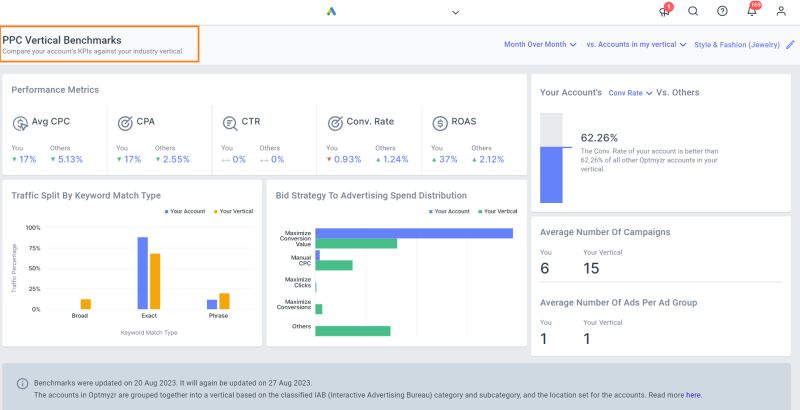Google is currently on trial for antitrust allegations from the US Justice Department, and Google employees have acknowledged what we’ve long known about how the ad auction works: Google controls the pricing — and sometimes raises auction minimums.
Here’s a rundown of just how Google controls auction pricing and what advertisers can do to protect their own interests.
Antitrust Trial: How Google Controls Advertising Costs
The trial has focused on Google allegedly using exclusionary tactics to maintain its dominance as the world’s leading search engine. But the US Justice Department is also making the case that Google has monopolistic power over search advertising as a specific industry.
Search ads make up the bulk of Google’s massive revenue, so how Google runs these auctions has become a point of scrutiny.
Ads May Be Promoted Out of Order to Boost Revenue
During the trial, a Google executive shared that the company frequently tweaks its ad auctions in ways that can raise prices for advertisers. One method is out-of-order ad promotion, where a lower-ranked ad gets promoted above a higher-ranked ad. This allows Google to generate more revenue by showing ads in locations with higher minimum prices.
In the ad auction, Google ranks all the eligible ads competing for each ad position on the search engine results page (SERP). The highest-ranked ad usually occupies the most prominent top position.
However, sometimes the top-ranked ad may be ineligible to show in that top spot due to certain rules Google has, even though it won the top rank. For example, Google may require ads in the top position to meet certain editorial or relevance standards that the top ad does not fulfill.
In this case, rather than leave the top spot empty, Google will do an out-of-order promotion. This means they will take the next highest-ranking eligible ad and promote it out of order above the ineligible top ad.
So if ad one ranks highest in the auction but cannot show in the top position, ad two (which ranked second) may get promoted to the top spot ahead of ad one. This allows Google to still show a relevant ad in the most visible placement, while adhering to their eligibility rules.
The key takeaway is that out-of-order promotion allows lower-ranked ads to jump ahead of higher-ranked ads when those top ads break rules about where they can appear on the SERP. It ensures Google can serve ads on premium real estate while enforcing editorial or relevance guidelines.
This helps Google make more money and is beneficial to advertisers because lower-ranked ads aren’t artificially held back by editorial or other issues with higher ranked ads.
Google Ads Auction Has Reserve Prices and Thresholds
The other technique Google deploys to improve its revenue is changing auction thresholds and reserve minimum pricing. Over time, this can increase the cost for advertisers to maintain an ad’s position.
The auction minimum CPM is the lowest amount an advertiser must pay to have their ad shown in a particular ad slot. The corresponding minimum CPC bid is determined by a combination of the auction reserve price and the Quality Score of each ad. Quality Score itself is based on factors like expected clickthrough rate and ad relevance.
Remember that Ad Rank is effectively the equivalent of CPM because in simple terms, Ad Rank is predicted CTR multiplied by CPC, which is predicted CPM.
When Google asks for a minimum CPM to show an ad in a particular location, and that ad’s predicted CTR is a static value determined by AI, the only lever the advertiser can control is their bid. So long as there is headroom with their maximum CPC, Google can raise the effective CPC to meet the new CPM threshold.
How Reserve Prices Raise Auction Prices
If Google increases an auction’s minimum bid, it raises the floor price to get into the auction. Advertisers who previously met the minimum bid at lower CPCs now have to bid higher just to participate and have a chance to show their ads.
They have to bid higher because the Quality Score of their ads is not something they can change on the fly – improving Quality Score takes time and effort.
So when the auction floor is raised, the only variable that can instantly change is the effective CPC. And so long as that effective CPC is below the maximum CPC, the automated auction can collect a higher cost for the click.
This not only increases costs for advertisers who were bidding near the floor price, but it can also raise costs across the board. Even advertisers who were bidding well above the minimum previously may see their costs go up.
Here’s why: In the auction, the top ad position goes to the highest bidder. When the minimum bid goes up, advertisers bidding near that level must increase their bids to participate. This then bumps up the amounts that slightly higher bidders need to pay to maintain their ad positions. Essentially it has a cascading effect across all bids.
So while the advertisers most impacted are those near the auction minimum, an increase to the minimum bid lifts the overall cost of entry and makes the auction more expensive for everyone. It raises the bar across the board in terms of the bids required to capture various ad positions on the page.
How to Safeguard Against Google’s Black Box of CPC Inflation
As we learned from testimony at the trial, these tactics are sometimes implemented to help Google meet financial targets. More importantly, Google does not notify advertisers when these pricing changes occur.
This may leave advertisers believing their optimizations were counterproductive and led to increased costs, when it was an external factor outside of advertisers’ control that caused the change in price.
Luckily, there are steps advertisers can take to manage this uncertainty.
Quality Score Remains an Important Cost Optimization Lever in PPC
The fundamentals of optimizing for quality score and predicted click-through rate remain essential. Focusing on these factors will help minimize what you pay in ad auctions, even as Google changes minimum price thresholds.
Google’s Quality Score algorithm is complex, but essentially it boils down to predicting clickthrough rate (CTR). The higher a keyword’s Quality Score, the more relevant Google thinks your ad will be for searches on that keyword.
This relevance translates into a better Ad Rank, and when your Ad Rank is higher, you pay less per click to maintain it.
Quality Score is calculated in part based on historical CTR data for your keywords and ads. But many other contextual factors are considered each time your ad enters the auction – like query intent, location, time of day, and more.
So Quality Score is very granular and constantly fluctuating.
The core factors that make up Quality Score are ad relevance to the search query, expected CTR, and landing page experience. When these elements are strong, your Quality Score improves, boosting Ad Rank and leading to lower average CPC.
So time invested in improving Quality Score by enhancing relevance has a clear payoff – maintained visibility at a lower cost.
Monitoring and Alerts Are Critical to Detect CPC Changes
PPC monitoring is critical to get alerts on price changes, and automated rules can pause campaigns if extreme anomalies are detected.
PPC management tools like Optmyzr provide (among other things) automated alerts when metrics deviate from goals. You can get notifications for changes in KPIs, budget pacing, or hitting targets. This allows you to address issues before they become larger problems.
Optmyzr also has customizable rules to tell campaigns what actions to take, like pausing or adding keywords to a report. And when a major performance shift occurs— both positive and negative—PPC Investigator can help analyze its root cause.
With Optmyzr’s robust PPC monitoring capabilities, you ensure the prices of your search ads don’t skyrocket out of control. It’s like insurance for your PPC account. This level of monitoring and automation is now table stakes, and imperative for any modern advertiser who wishes to stay on top of volatile auction dynamics.
Use Vertical Benchmarks to Know Whether CPC Increases Are Your Doing
PPC Vertical Benchmarks in Optmyzr helps advertisers understand the performance of their account relative to that of similar advertisers.
Comparing your metrics to vertical-specific benchmarks lets you assess whether a price increase is an industry-wide trend or unique to your account. This context helps determine the best optimization approach:
- If your CPC went up but others’ CPCs increased by more, you’re probably on the right path.
- If your CPC increased more than those of your industry peers, it may be time to enable additional optimizations – deploying more negative keywords, adjusting target CPA and target ROAS, and rewriting your responsive search ads to be more relevant.

Watch the Trial – And Your Google Ads Accounts
Google’s antitrust trial is still ongoing and may reveal more about the tech giant’s ad practices. If Google is found to be a monopoly, structural changes to auctions could follow.
As the situation evolves, advertisers need the flexibility and control to respond swiftly. The core principles of automation, vigilance, and relying on data hold true to navigate an ever-changing auction landscape.
If you’d like to try any of the tools mentioned in this article, start your two-week trial of Optmyzr today.


Stay ahead with Google Ads despite industry setbacks
Equip yourself with the tools to navigate changes in Google Ads with Optmyzr. Start your two-week trial today and gain the flexibility and control you need.
Try Optmyzr now








